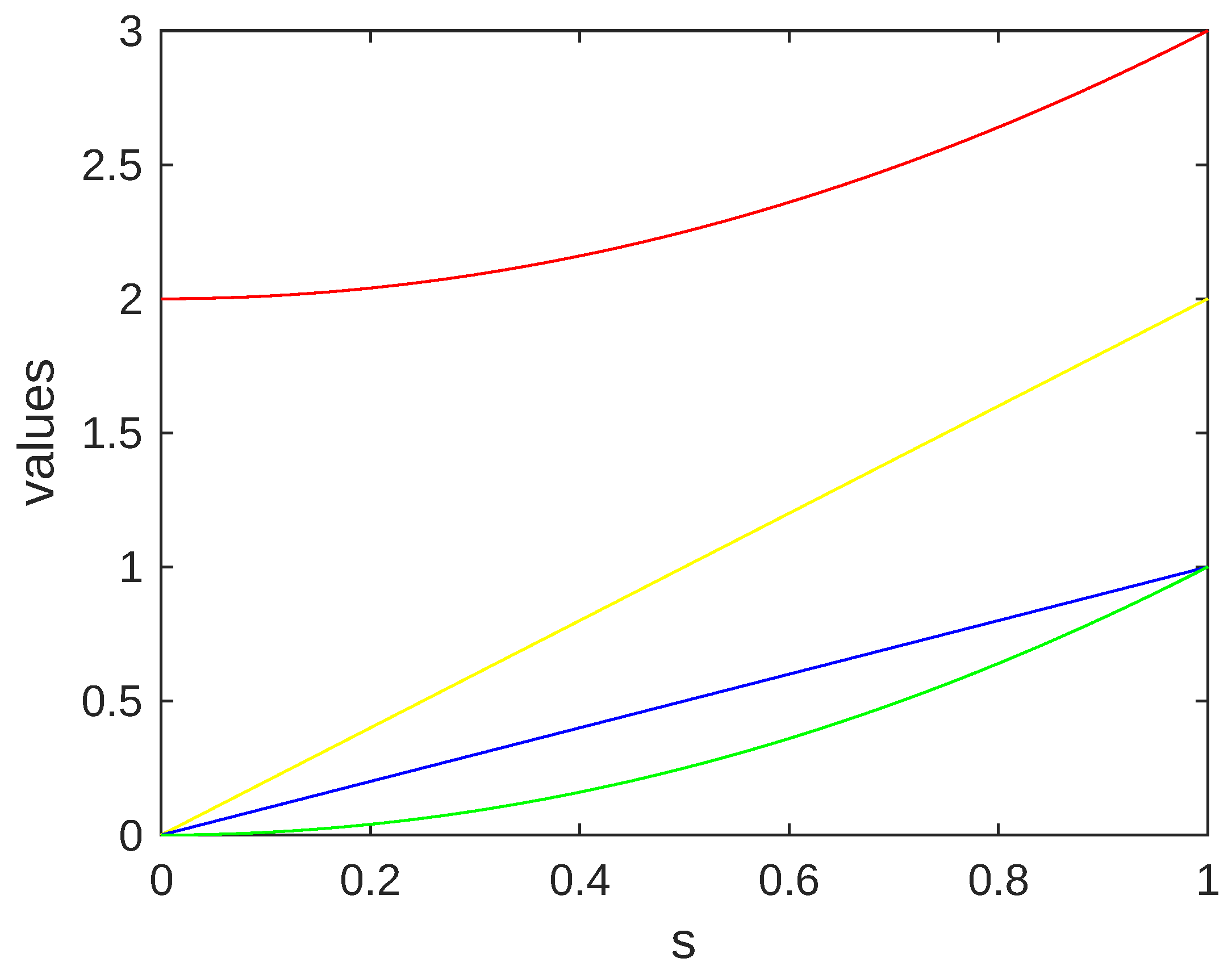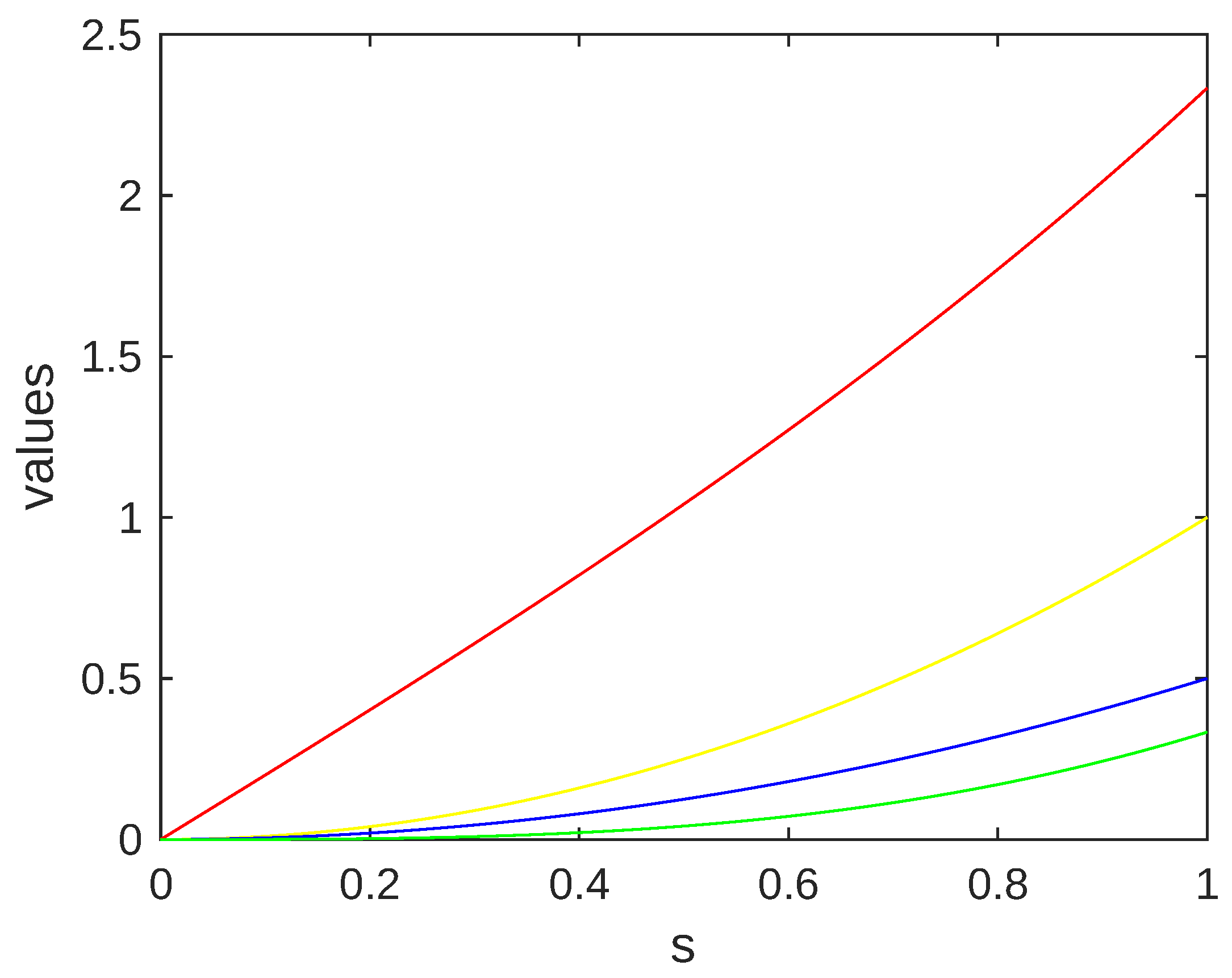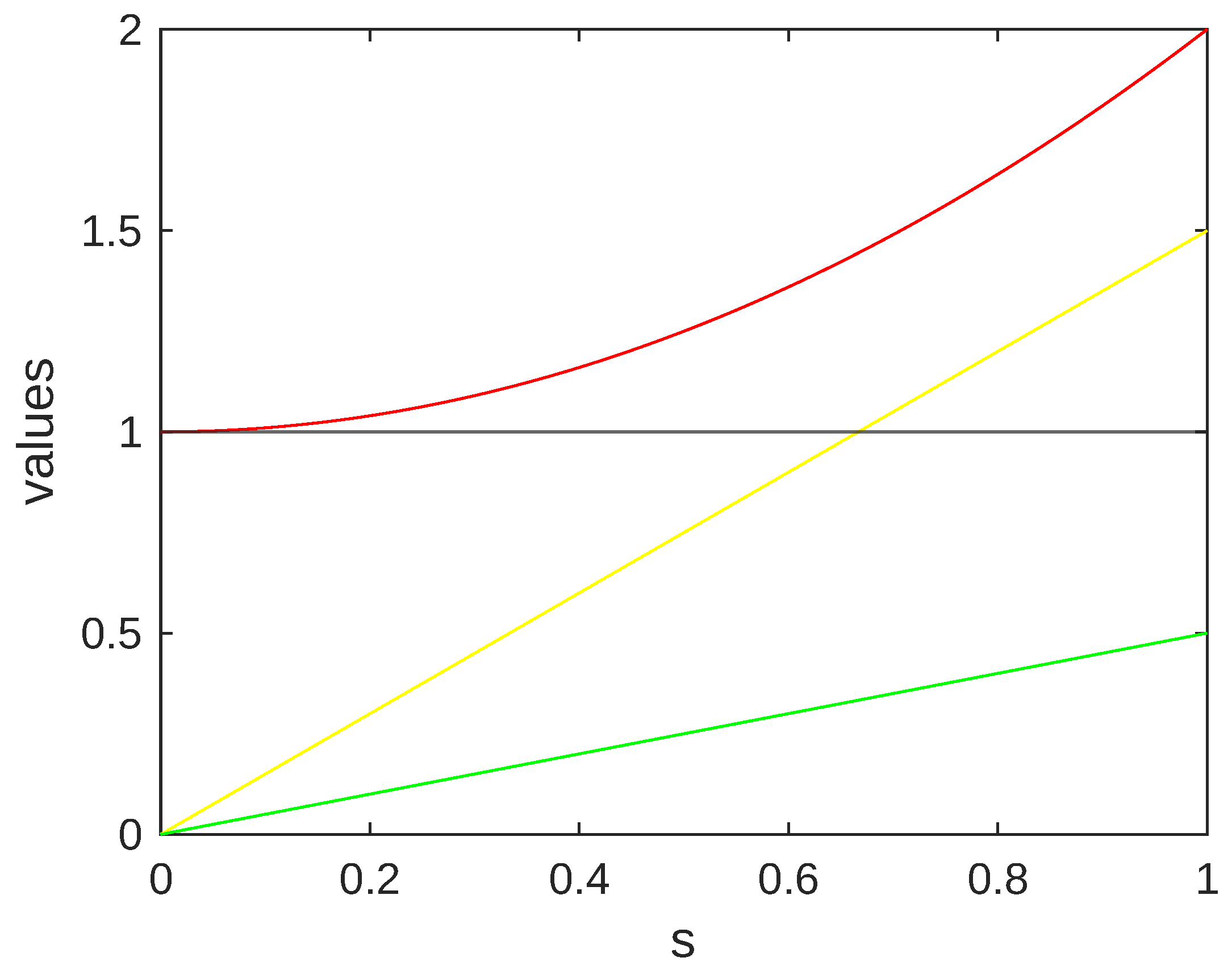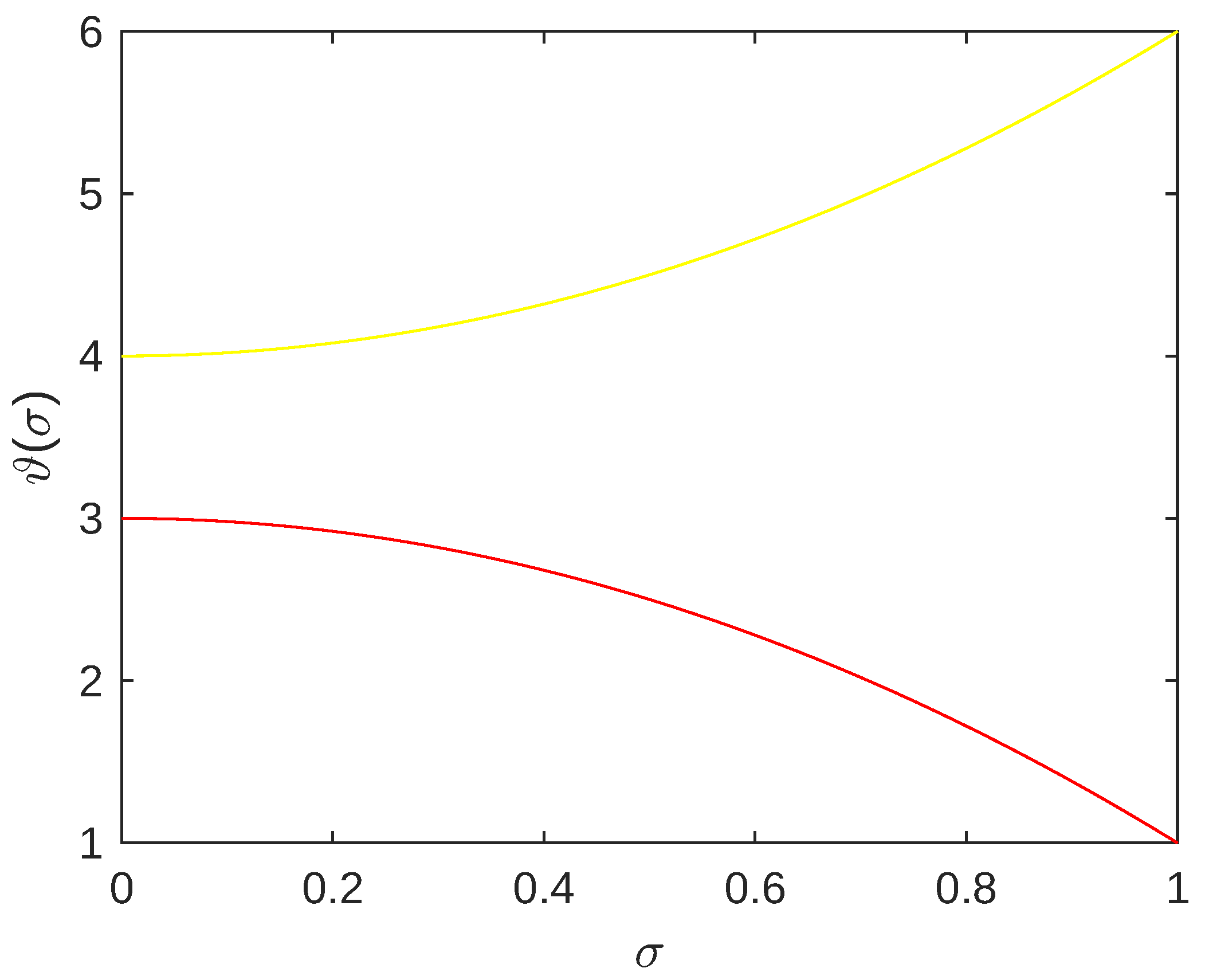Some Novel Estimates of Hermite–Hadamard and Jensen Type Inequalities for (h1,h2)-Convex Functions Pertaining to Total Order Relation
Abstract
1. Introduction
2. Preliminaries
3. Main Results
- (i)
- If , Theorem 4 incorporates output for CR-P-function:
- (ii)
- If and , Theorem 4 incorporates output for CR-h-GL-function:
- (iii)
- If and , Theorem 4 incorporates output for CR-h-convex function:
- (iv)
- If and , Theorem 4 incorporates output for CR--convex function:
4. Jensen Type Inequality for CR--Convex Mapping
- (i)
- If , Theorem 8 incorporates output for CR- P-function:
- (ii)
- If and , Theorem 8 incorporates output for CR--GL function:
- (iii)
- If and , Theorem 8 incorporates output for CR-convex function:
- (iv)
- If and , Theorem 8 incorporates output for CR-h-convex function:
- (v)
- If and , Theorem 8 incorporates output for CR-h-GL-function:
- (vi)
- If and , Theorem 8 incorporates output for CR-s-convex function:
5. Conclusions
Author Contributions
Funding
Institutional Review Board Statement
Informed Consent Statement
Data Availability Statement
Acknowledgments
Conflicts of Interest
References
- Moore, R.E. Interval Analysis; Prentice-Hall: Hoboken, NJ, USA, 1966. [Google Scholar]
- Snyder, J.M. Interval analysis for computer graphics. In Proceedings of the 19th Annual Conference on Computer Graphics and Interactive Techniques, Chicago, IL, USA, 27–31 July 1992; pp. 121–130. [Google Scholar]
- Qian, Y.; Liang, J.; Dang, C. Interval ordered information systems. Comput. Math. Appl. 2008, 56, 1994–2009. [Google Scholar] [CrossRef]
- Rothwell, E.J.; Cloud, M.J. Automatic error analysis using intervals. IEEE Trans. Educ. 2011, 55, 9–15. [Google Scholar] [CrossRef]
- Rahman, M.S.; Shaikh, A.A.; Bhunia, A.K. Necessary and sufficient optimality conditions for non-linear unconstrained and constrained optimization problem with interval valued objective function. Comput. Ind. Eng. 2020, 147, 106634. [Google Scholar] [CrossRef]
- De Weerdt, E.; Chu, Q.P.; Mulder, J.A. Neural network output optimization using interval analysis. IEEE Trans. Neural Netw. 2009, 20, 638–653. [Google Scholar] [CrossRef][Green Version]
- Gao, W.; Song, C.; Tin-Loi, F. Probabilistic interval analysis for structures with uncertainty. Struct. Saf. 2010, 32, 191–199. [Google Scholar] [CrossRef]
- Wang, X.; Wang, L.; Qiu, Z. A feasible implementation procedure for interval analysis method from measurement data. Appl. Math. Model. 2014, 38, 2377–2397. [Google Scholar] [CrossRef]
- Stojiljković, V.; Ramaswamy, R.; Ashour Abdelnaby, O.A.; Radenović, S. Riemann-Liouville Fractional Inclusions for Convex Functions Using Interval Valued Setting. Mathematics 2022, 10, 3491. [Google Scholar] [CrossRef]
- Stojiljković, V.; Ramaswamy, R.; Alshammari, F.; Ashour, O.A.; Alghazwani, M.L.H.; Radenović, S. Hermite–Hadamard Type Inequalities Involving (k-p) Fractional Operator for Various Types of Convex Functions. Fractal Fract. 2022, 6, 376. [Google Scholar] [CrossRef]
- Faisal, S.; Khan, M.A.; Iqbal, S. Generalized Hermite–Hadamard-Mercer type inequalities via majorization. Filomat 2022, 36, 469–483. [Google Scholar] [CrossRef]
- Afzal, W.; Shabbir, K.; Botmart, T.; Treanţă, S. Some new estimates of well known inequalities for (h1,h2)-Godunova-Levin functions by means of center-radius order relation. AIMS Math. 2023, 8, 3101–3119. [Google Scholar] [CrossRef]
- Dragomir, S.S. Inequalities of Hermite–Hadamard type for functions of selfadjoint operators and matrices. J. Math. Inequalities 2017, 11, 241–259. [Google Scholar] [CrossRef]
- Kamenskii, M.; Petrosyan, G.; Wen, C.F. An existence result for a periodic boundary value problem of fractional semilinear differential equations in a Banach space. J. Nonlinear Var. Anal. 2021, 5, 155–177. [Google Scholar]
- Zhao, D.; An, T.; Ye, G.; Torres, D.F. On Hermite–Hadamard type inequalities for harmonical h-convex interval-valued functions. arXiv 2019, arXiv:1911.06900. [Google Scholar]
- Khan, M.B.; Macías-Díaz, J.E.; Treanţă, S.; Soliman, M.S.; Zaini, H.G. Hermite–Hadamard Inequalities in Fractional Calculus for Left and Right Harmonically Convex Functions via Interval-Valued Settings. Fractal Fract. 2022, 6, 178. [Google Scholar] [CrossRef]
- Afzal, W.; Alb Lupaş, A.; Shabbir, K. Hermite–Hadamard and Jensen-Type Inequalities for Harmonical (h1,h2)-Godunova–Levin Interval-Valued Functions. Mathematics 2022, 10, 2970. [Google Scholar] [CrossRef]
- Niculescu, C.P.; Persson, L.E. Old and new on the Hermite–Hadamard inequality. Real Anal. Exch. 2004, 29, 663–686. [Google Scholar] [CrossRef]
- Abdeljawad, T.; Rashid, S.; Khan, H.; Chu, Y.M. On new fractional integral inequalities for p-convexity within interval-valued functions. Adv. Differ. Equ. 2020, 2020, 330. [Google Scholar] [CrossRef]
- Nwaeze, E.R.; Khan, M.A.; Chu, Y.M. Fractional inclusions of the Hermite–Hadamard type for m-polynomial convex intervalvalued functions. Adv. Differ. Equ. 2020, 2020, 507. [Google Scholar] [CrossRef]
- Afzal, W.; Nazeer, W.; Botmart, T.; Treanţă, S. Some properties and inequalities for generalized class of harmonical Godunova-Levin function via center radius order relation. AIMS Math. 2022, 8, 1696–1712. [Google Scholar] [CrossRef]
- Mihai, M.V.; Awan, M.U.; Noor, M.A.; Kim, J.K.; Noor, K.I. Hermite–Hadamard inequalities and their applications. J. Inequalities Appl. 2018, 2018, 309. [Google Scholar] [CrossRef]
- Xiao, L.; Lu, G. A new refinement of Jensen’s inequality with applications in information theory. Open Math. 2020, 18, 1748–1759. [Google Scholar] [CrossRef]
- Awan, M.U.; Noor, M.A.; Safdar, F.; Islam, A.; Mihai, M.V.; Noor, K.I. Hermite–Hadamard type inequalities with applications. Miskolc Math. Notes 2020, 21, 593–614. [Google Scholar] [CrossRef]
- Breckner, W.W. Continuity of generalized convex and generalized concave set-valued functions. Rev. D’Anal. Numér. Théor. Approx. 1993, 22, 39–51. [Google Scholar]
- Chalco-Cano, Y.; Flores-Franulic, A.; Román-Flores, H. Ostrowski type inequalities for interval-valued functions using generalized Hukuhara derivative. Comput. Appl. Math. 2012, 31, 457–472. [Google Scholar]
- Costa, T.M.; Román-Flores, H.; Chalco-Cano, Y. Opial-type inequalities for interval-valued functions. Fuzzy Sets Syst. 2019, 358, 48–63. [Google Scholar] [CrossRef]
- Zhao, D.; An, T.; Ye, G.; Liu, W. New Jensen and Hermite–Hadamard type inequalities for h-convex interval-valued functions. J. Inequalities Appl. 2018, 1, 302. [Google Scholar] [CrossRef]
- Wu, Y.; Qi, F. Discussions on two integral inequalities of Hermite–Hadamard type for convex functions. J. Comput. Appl. Math. 2022, 406, 114049. [Google Scholar] [CrossRef]
- Macías-Díaz, J.E.; Khan, M.B.; Noor, M.A.; Abd Allah, A.M.; Alghamdi, S.M. Hermite–Hadamard inequalities for generalized convex functions in interval-valued calculus. AIMS Math. 2022, 7, 4266–4292. [Google Scholar] [CrossRef]
- Khan, M.B.; Srivastava, H.M.; Mohammed, P.O.; Nonlaopon, K.; Hamed, Y.S. Some new Jensen, Schur and Hermite–Hadamard inequalities for log convex fuzzy interval-valued functions. AIMS Math. 2022, 7, 4338–4358. [Google Scholar] [CrossRef]
- Khan, M.B.; Noor, M.A.; Shah, N.A.; Abualnaja, K.M.; Botmart, T. Some New Versions of Hermite–Hadamard Integral Inequalities in Fuzzy Fractional Calculus for Generalized Pre-Invex Functions via Fuzzy-Interval-Valued Settings. Fractal Fract. 2022, 6, 83. [Google Scholar] [CrossRef]
- Awan, M.U. Some new classes of convex functions and inequalities. Miskolc Math. Notes 2018, 19, 77–94. [Google Scholar] [CrossRef]
- Liu, R.; Xu, R. Hermite–Hadamard type inequalities for harmonical convex interval-valued functions. Math. Found. Comput. 2021, 4, 89. [Google Scholar] [CrossRef]
- Yang, W.G. Hermite–Hadamard type inequalities for (p1,h1)-(p2,h2)-convex functions on the co-ordinates. Tamkang J. Math. 2016, 2016 47, 289–322. [Google Scholar] [CrossRef]
- Shi, D.P.; Si, B.Y.; Qi, F. Hermite–Hadamard type inequalities for (m,h1,h2)-convex functions via Riemann–Liouville fractional integrals. Turkish J. Anal. Number Theory 2014, 2, 22–27. [Google Scholar] [CrossRef][Green Version]
- An, Y.; Ye, G.; Zhao, D.; Liu, W. Hermite–Hadamard type inequalities for interval (h1,h2)-convex functions. Mathematics 2019, 7, 436. [Google Scholar] [CrossRef]
- Bai, H.; Saleem, M.S.; Nazeer, W.; Zahoor, M.S.; Zhao, T. Hermite–Hadamard-and Jensen-type inequalities for interval nonconvex function. J. Math. 2020, 2020, 3945384. [Google Scholar] [CrossRef]
- Afzal, W.; Shabbir, K.; Botmart, T. Generalized version of Jensen and Hermite–Hadamard inequalities for interval-valued (h1,h2)-Godunova-Levin functions. AIMS Math. 2022, 7, 19372–19387. [Google Scholar] [CrossRef]
- Zhang, S.; Shabbir, K.; Afzal, W.; Siao, H.; Lin, D. Hermite–Hadamard and Jensen-Type Inequalities via Riemann Integral Operator for a Generalized Class of Godunova–Levin Functions. J. Math. 2022, 2022, 3830324. [Google Scholar] [CrossRef]
- Saeed, T.; Afzal, W.; Abbas, M.; Treanţă, S.; De la Sen, M. Some New Generalizations of Integral Inequalities for Harmonical cr-(h1,h2)-Godunova-Levin Functions and Applications. Mathematics 2022, 10, 4540. [Google Scholar] [CrossRef]
- Ali, S.; Ali, R.S.; Vivas-Cortez, M.; Mubeen, S.; Rahman, G.; Nisar, K.S. Some fractional integral inequalities via h-Godunova–Levin preinvex function. AIMS Math. 2022, 7, 13832–13844. [Google Scholar] [CrossRef]
- Khan, M.B.; Noor, M.A.; Al-Bayatti, H.M.; Noor, K.I. Some new inequalities for LR-log-h-convex interval-valued functions by means of pseudo order relation. Appl. Math. Inf. Sci. 2021, 15, 459–470. [Google Scholar]
- Hosseini, M.; Babakhani, A.; Agahi, H.; Rasouli, S.H. On pseudo-fractional integral inequalities related to Hermite–Hadamard type. Soft Comput. 2016, 20, 2521–2529. [Google Scholar] [CrossRef]
- Afzal, W.; Shabbir, K.; Treanţă, S.; Nonlaopon, K. Jensen and Hermite-Hadamard type inclusions for harmonical h-Godunova-Levin functions. AIMS Math. 2023, 8, 3303–3321. [Google Scholar] [CrossRef]
- Bhunia, A.K.; Samanta, S.S. A study of interval metric and its application in multi-objective optimization with interval objectives. Comput. Ind. Eng. 2014, 74, 169–178. [Google Scholar] [CrossRef]
- Liu, W.; Shi, F.; Ye, G.; Zhao, D. The Properties of Harmonically CR-h-Convex Function and Its Applications. Mathematics 2022, 10, 2089. [Google Scholar] [CrossRef]
- Afzal, W.; Abbas, M.; Macías-Díaz, J.E.; Treanţă, S. Some H-Godunova–Levin Function Inequalities Using Center Radius (CR) Order Relation. Fractal Fract. 2022, 6, 518. [Google Scholar] [CrossRef]
- Markov, S. Calculus for interval functions of a real variable. Computing 1979, 22, 325–337. [Google Scholar] [CrossRef]




Publisher’s Note: MDPI stays neutral with regard to jurisdictional claims in published maps and institutional affiliations. |
© 2022 by the authors. Licensee MDPI, Basel, Switzerland. This article is an open access article distributed under the terms and conditions of the Creative Commons Attribution (CC BY) license (https://creativecommons.org/licenses/by/4.0/).
Share and Cite
Saeed, T.; Afzal, W.; Shabbir, K.; Treanţă, S.; De la Sen, M. Some Novel Estimates of Hermite–Hadamard and Jensen Type Inequalities for (h1,h2)-Convex Functions Pertaining to Total Order Relation. Mathematics 2022, 10, 4777. https://doi.org/10.3390/math10244777
Saeed T, Afzal W, Shabbir K, Treanţă S, De la Sen M. Some Novel Estimates of Hermite–Hadamard and Jensen Type Inequalities for (h1,h2)-Convex Functions Pertaining to Total Order Relation. Mathematics. 2022; 10(24):4777. https://doi.org/10.3390/math10244777
Chicago/Turabian StyleSaeed, Tareq, Waqar Afzal, Khurram Shabbir, Savin Treanţă, and Manuel De la Sen. 2022. "Some Novel Estimates of Hermite–Hadamard and Jensen Type Inequalities for (h1,h2)-Convex Functions Pertaining to Total Order Relation" Mathematics 10, no. 24: 4777. https://doi.org/10.3390/math10244777
APA StyleSaeed, T., Afzal, W., Shabbir, K., Treanţă, S., & De la Sen, M. (2022). Some Novel Estimates of Hermite–Hadamard and Jensen Type Inequalities for (h1,h2)-Convex Functions Pertaining to Total Order Relation. Mathematics, 10(24), 4777. https://doi.org/10.3390/math10244777







